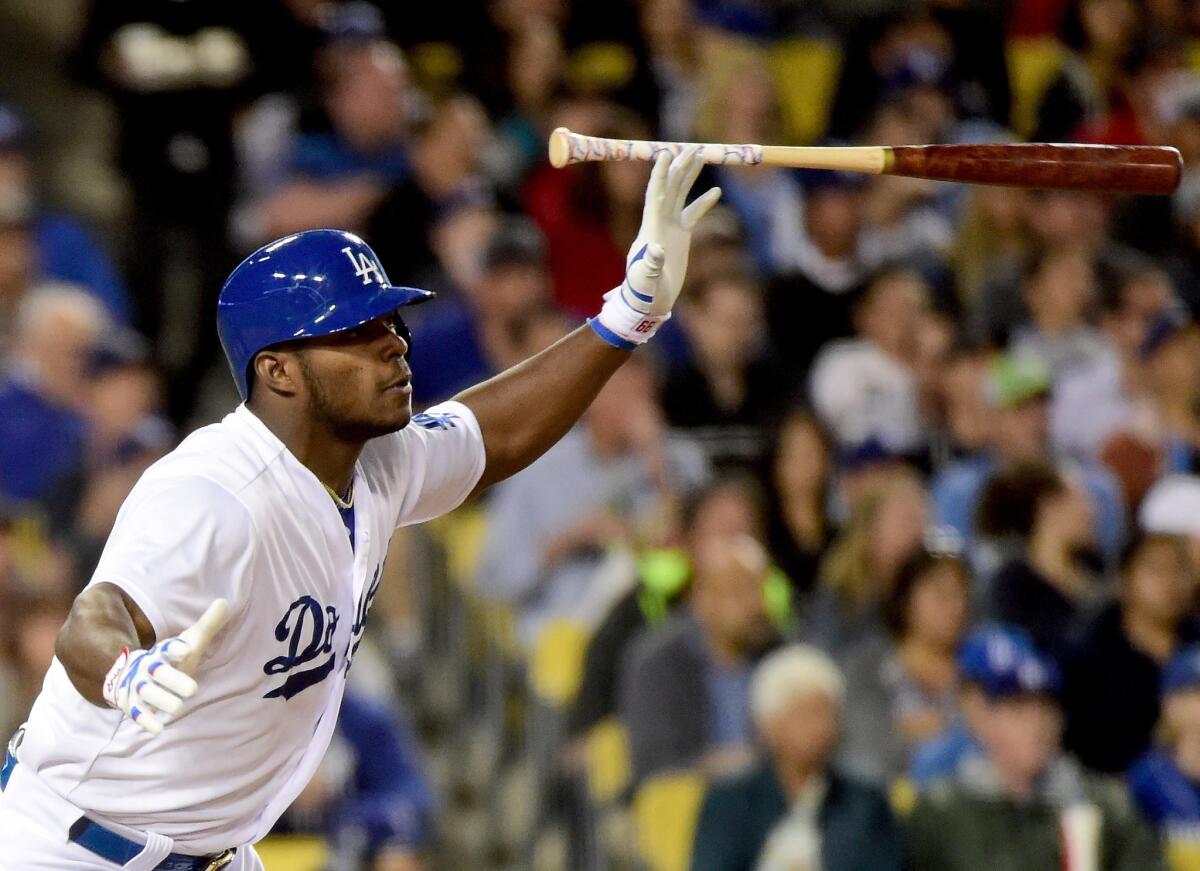The bat flip, a la Yasiel Puig, no longer seems a reason to flip out

- Share via
Years ago, back when Yasiel Puig was a 3-year-old in Cuba, a triple-A player in Buffalo named Rich Aude displayed a home-run celebration that would put any of Puig’s bat flips to shame.
Aude hit a walk-off home run. He watched it fly for several seconds, then walked halfway to first base, bobbed his head and stared at the pitcher.
The coup de grace was something that has become increasingly familiar in today’s game: still staring, he flipped his bat about 10 feet toward the sky.
It ignited a confrontation between the teams, and even Aude’s manager took exception.
“Basketball is in-your-face,” the manager, Doc Edwards, told the Buffalo News, “but not baseball.”
Times have changed. Today, Puig and players across the big leagues have made the bat flip a staple — and not only after home runs.
Last week, when the Dodgers right fielder returned from a six-week stint on the disabled list, Puig punctuated his first hit, a double, with a mini bat flip.
The flip has become so much a personal signature that Puig is trying to tone down the practice because he fears the habit — born during his amateur days in Cuba, where the players tend to be more animated — has been giving the wrong impression.
“I want to show American baseball that I’m not disrespecting the game,” he said several weeks ago, before a hamstring injury prompted his extended stay on the DL.
While he was out, something strange happened. Players flipped their bats after home runs, singles, even a walk — and no one has seemed to care.
Earlier this season, Dodgers pitcher Zack Greinke tossed his bat theatrically after a double and smiled wryly on second base. Retribution was not sought.
The move has become so common, Dodgers catcher A.J. Ellis says he no longer even notices.
“As long as nothing’s done maliciously to offend the opposing team,” Ellis said. “If it’s only done in genuine excitement to what’s accomplished for your own team, I have no issue in any way with people celebrating.”
Since pitchers are now joining in the fun, Ellis wondered, why get worked up about it? He noted wryly that “Nobody in the game’s got a bigger bat flip than Zack Greinke right now.”
Baseball doesn’t have a rule about what a batter must do with his bat. It is perfectly legal, for instance, to round the bases with bat in hand the entire time, though it is unlikely that’s been tried.
But at some point, American baseball culture deemed bat flipping taboo. Before Puig, the celebratory bat flip was in the same category as a retired batter’s running across the mound on his way back to the dugout, said Jason Turbow, author of “Baseball Codes: Beanballs, Sign Stealing, and Bench-Clearing Brawls.”
Then along came Puig, the Johnny Appleseed of the bat flip.
Puig didn’t start the practice, but he brought it into the mainstream, Turbow said. Early this season, the Dodgers released a commercial that showed a young fan flipping his pencils and sandwiches into the air, just like his hero.
For the Dodgers, a promotional opportunity. Elsewhere, though, Puig’s antics were met with some hostility, at least initially.
Often, disputes over American baseball’s etiquette are loaded with cultural elements. Puig has attracted scrutiny because of his flamboyance, which he is not oblivious to. He didn’t say he needed to show “baseball” he was respecting the game. He needed to show “American baseball.”
Baseball in Latin America tends to be more demonstrative. When more Latinos joined the the majors, they were pressured to conform, to tone it down — by opponents, reporters, coaches, even teammates, Turbow said.
“The Latino celebrations, which are traditionally a little more exuberant than their American counterparts, haven’t always been accepted on that same code, even though it’s simply a look-at-me-have-fun thing,” Turbow said.
Partly because of Puig, bat flips have been associated with Latino players, but there is also a robust bat-flipping culture in Korea.
That was a topic of conversation in January at a seminar run by Global Sporting Integration, a company that helps players make the transition between American and Asian baseball.
American pitchers headed to South Korea were told, simply, “hitters are going to pimp” home runs, said Han Gil Lee, the company’s founder. That’s normal, he told them, so no need to retaliate with a beanball.
Videos showing the Korean Baseball Organization’s post-home-run antics have been making the Internet rounds. A player named Kim Jin-hyung is famously shown flinging his bat as if it had burst into flames.
There are also clips of the dreaded premature bat flip: Choi Jun-seok, hands in the air, sending his bat flying on a ball that was about 30 feet foul; and Lee Taek-keun, chucking his bat and beginning a celebratory walk/strut until he sees the ball caught at the wall.
By comparison, Puig is subdued.
“I don’t think the Korean players see it as a sign of disrespect,” Lee said. Rather, it’s just a way to get rid of a bat.
Dodgers pitcher Hyun-Jin Ryu, who played in the KBO and still watches the league, said he paid the bat flips little attention.
They were such a non-issue, he said, that he hadn’t noticed them at all.
To that, Puig can’t relate.
When he’s on the field, Puig commands attention, bat flips or not.
More to Read
Go beyond the scoreboard
Get the latest on L.A.'s teams in the daily Sports Report newsletter.
You may occasionally receive promotional content from the Los Angeles Times.











